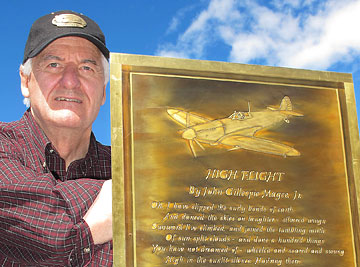Local entrepreneur’s heart soars with High Flight poet
COFFEE WITH WARREN, with Warren Harbeck
Cochrane Eagle, June 30, 2010

Aerospace visionary Sandford “Sandy” McLeod holds a brass plaque inscribed with the words of High Flight, John Gillespie Magee, Jr.’s poem celebrating the joy of flying.
Photo by Warren Harbeck
Last week’s column on potter Nicole Byl referred to John Gillespie Magee, Jr.’s poem, High Flight. Most high school graduates in Canada are familiar with its opening and closing lines: “Oh! I have slipped the surly bonds of Earth . . .Put out my hand, and touched the face of God.”
For one Bragg Creek coffee companion, however, the poem has been much more than a classroom assignment. For Sandford “Sandy” McLeod it has been a constant companion throughout his long career as a leader in the aerospace industry.
Sandy is a pilot who delights in slipping the “surly bonds.” He’s also an aviation engineer and entrepreneur whose company, Tower Aerospace Inc., has designed many of the complex operating systems used in modern aircraft. (His helitanker water delivery system for wildfire control can be viewed at www.toweraerospace.com/badger_overview.php.)
As soon as he read the column, he e-mailed me about a treasure of his that hangs on his office wall. It’s a beautifully crafted brass plaque featuring the entire 14 lines of Magee’s celebration of flight. He’d bring it to our next coffee together.
For some time, Sandy and I had been discussing how the visible, tangible things and experiences of life reveal the invisible. Reference to Magee’s poem brought the topic into sharp focus for Sandy.
“Magee captured the essence of invisible to visible,” Sandy said.
He recalled a moment over 50 years ago when he was 18, an airman just learning how to fly.
“I was over Lake Winnipeg at 42,000 feet in a pressurized T-33 jet trainer,” he said. “Early in the morning the captain and I witnessed the vast darkness of the universe. I looked up through the canopy and all I could see was darkness that went forever. And stars! And the sun emerging from the darkness as only a small dot on the horizon.
“We soared and twisted and turned in a silence that was overwhelming. We heard only a quiet sound behind us from the jet engine (the only man-made power between us and earth) and the soft swishing sound of the wind over the wings, very soft.
“The vastness was completely overwhelming to the point of total wonderment and awe, in a way a soft shock to the mind: How powerful are the universe and endless galaxies? How powerful is God? It was as though He was calling us for a brief few minutes, until regretfully we had to return to human earth.”
Magee, of course, wrote his poem in 1941, an American flying with the Royal Canadian Air Force in a Spitfire during World War II, 18 years before Sandy and his captain had their profound moment.
“He in a ‘Spit’ at 30,000 feet was no different than me alone up there on the lower edge of space,” Sandy said, “a different man, a different background, almost 20 years apart who experienced the same thing.
“The point is, we all see the invisible and make it visible through experiences such as these, guided by God. The humility that goes along with those experiences is for me totally overwhelming. I am left in tears, and I keep my mouth shut for fear of people thinking I am a little ‘loony.’”
Sandy has often read Magee’s poem to Remembrance Day audiences, and whenever he does, shivers go through him.
“I feel him talking to me; we shared the same flight, God’s flight for us,” he said.
“I try and have the audience open their mind to the invisible in the visible and that nothing is impossible. Magee knew it, I know it, from our dual, individual flights, 20 years apart in very different technology.”
And so, let us join Sandy in a toast: To the poet who soared “up, up the long, delirious, burning blue . . . topped the wind-swept height with easy grace . . . trod . . . the high untrespassed sanctity of space,” put out his hand “and touched the face of God.”
© 2010 Warren Harbeck
JoinMe@coffeewithwarren.com